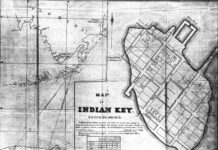UPPER KEYS
P.F. “Bud” and Martha McKenney came to visit the Florida Keys from Atlanta, Georgia where they operated a series of ice cream parlors. During their stay, they looked at a flooded railroad quarry on Windley Key and decided on a lifestyle change. The McKenneys went home to Atlanta, sold their business, and moved to the Keys.
When they arrived in 1941, the McKenneys leased the flooded quarry pit and its surrounding acreage from Alonzo Cothron. With the help of Cothron, McKenney worked to further develop the property into the 17-acre roadside attraction known as Theater of the Sea. Theater of the Sea became the second marine life related attraction in the Keys. The first had been the Key West Aquarium, one of President Franklin D. Roosevelt’s Federal Emergency Relief Administration programs developed in response to the Great Depression. When Theater of the Sea opened its doors for business in 1946, admission prices were $1.50 for adults and 55 cents for children over 7.
The park’s first performing dolphins were captured and trained by Grassy Key legend Milton Santini, considered a pioneer in the art of capturing, transporting, and training wild dolphins. Santini’s most famous pupil was Mitzi, the dolphin best remembered for her role as Flipper. Brad Bertelli is curator of the Keys History & Discovery Center. Photo: Jerry Wilkinson Collection
MARATHON
 While Milton Santini was small in stature, his contribution to the history of the Florida Keys was larger than life. Of Mediterranean descent, Santini made his living as a fisherman. What brought the man such notoriety was his skill at catching dolphin — and not the catch of the day served in area restaurants, but Flipper dolphin. During the 1940s and 1950s sea aquariums began to spring up around the country and Santini made a name for himself capturing the marine mammals. Santini would catch the first dolphins exhibited at Windley Key’s Theater of the Sea. When the Miami Sea Aquarium was built, the facility offered $100 per live dolphin delivered to Tavernier or Marathon. By 1962, calls for wild dolphin were coming in from as far away as Texas and Michigan.
While Milton Santini was small in stature, his contribution to the history of the Florida Keys was larger than life. Of Mediterranean descent, Santini made his living as a fisherman. What brought the man such notoriety was his skill at catching dolphin — and not the catch of the day served in area restaurants, but Flipper dolphin. During the 1940s and 1950s sea aquariums began to spring up around the country and Santini made a name for himself capturing the marine mammals. Santini would catch the first dolphins exhibited at Windley Key’s Theater of the Sea. When the Miami Sea Aquarium was built, the facility offered $100 per live dolphin delivered to Tavernier or Marathon. By 1962, calls for wild dolphin were coming in from as far away as Texas and Michigan.
Santini reached his legendary status when he caught and trained the world’s most famous dolphin, one he fished out of Florida Bay in 1955. He named her Mitzi. Mitzi was a natural performer and quick to learn tricks. Mitzi, of course, gained notoriety when she was cast to portray the beloved character Flipper. Mitzi was one of several dolphins to perform in the role but was, allegedly, the most photogenic of the bunch. At his Grassy Key facility, Santini charged the local school children a quarter to slip into Mitzi’s pool and swim with her. He also opened the roadside attraction Santini’s Porpoise School where Mitzi was one of as many as 15 performing dolphins. Mitzi was the star of the show until 1972, when she died of heart failure. Brad Bertelli is curator of the Keys History & Discovery Center. Photo: Dolphin Research Center
KEY WEST

The Key West Aquarium was a project associated with President Franklin D. Roosevelt’s New Deal promising relief, recovery and reform. One of the agencies established was the Federal Emergency Relief Administration. Florida’s first FERA administrator was Julius Stone. A graduate of Harvard University, Stone had an affinity for Key West and opened an office in the Southernmost City. Living there, he understood that while Flagler’s railroad brought the train to Key West, it was not bringing much of a tourist trade. Stone was convinced that, with a little bit of help, Key West could become the “Gibraltar of the South.”
Stone organized hundreds of Key West residents into a volunteer corps responsible for beautifying the town. Two hundred houses were refurbished so that they could be rented by visitors, primary streets were landscaped, and beaches cleaned up. Construction of the Key West Aquarium began in 1933. Built to help lure tourists to the island, the marine life facility opened to the public Feb. 18, 1935. Admission was 15 cents for adults and 5 cents for children. The aquarium would close and be leased to the U.S. government in 1943. It was used as a firing range, but not for long. The facility would reopen as the Key West Aquarium in 1946. It is sometimes referred to as a WPA project, but the Works Progress Administration would not form until May 6, 1935, six months after the attraction first opened. Brad Bertelli is curator of the Keys History & Discovery Center. Photo: Florida Memory Project
— BRAD BERTELLI, Curator Keys History & Discovery Center

























